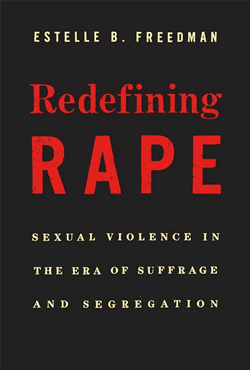BOOK REVIEW
Barnard Alum/Stanford Professor Examines History of Rape
Reviewed By Merri Rosenberg
 Redefining Rape: Sexual Violence In The Era Of Suffrage & Segregation
Redefining Rape: Sexual Violence In The Era Of Suffrage & Segregation
By Estelle B. Freedman
Published by Harvard University Press. Cambridge, Massachusetts and London, England, 2013: 387 pp.
At a time when many Americans were appalled that a United States politician could suggest that somehow there was a distinction between “legitimate rape”, and something else, Estelle Freedman’s comprehensive study is certainly timely.
Freedman, a Barnard College alumna who is the Edgar E. Robinson Professor in United States History at Stanford University, approaches her provocative subject with impressive academic rigor and analysis, yet weaves her narrative with an eye to how the definition and prosecution of rape has played out at specific historic moments.
Whether it was a question of rape as a matter of seeing women as a man’s property (and white women at that), or as a racially charged crime that usually meant rape was “defined either in law or through practice as a crime committed largely by African American men against chaste white women,” it’s been an ugly lens through which to see the nation’s complicated history.
Further, suggests Freedman, how rape has been defined has all too often meant that it’s been under reported or used to further other agendas. It’s telling that, as Freedman frames the efforts by suffragists in the early 20th century and feminists in the later part of the 20th century to redefine rape comes from “the recognition that white men’s freedom to be sexually violent or coercive lay at the heart of their political power.”
It’s certainly disturbing to consider the role that rape played in the lynching of African-American men in the South, or how accusations of inter-racial rape led to the trials of the Scottsboro boys in Alabama in 1930. The lack of protection for African American women who were sexually assaulted reflected political realities; “at the end of the century, as southern states disenfranchised black men and institutionalized racial segregation, the continued rape of black women by white men strengthened white supremacy.”
She also handles the issues related to the age of consent (at one time, it was ten years of age) and what consent actually meant; homosexual rape and sexual assault; how a shift in thinking about sexual privacy offered more rights to men accused of rape, and how women in the early 1970s pushed back against the idea that women somehow “asked for” rape by the way they dressed or behaved, shifting the conversation to see rape as a violent crime rather than simply a sexual one.
Freedman makes a powerful contribution to the on-going national discourse about rape, even if it’s discouraging that the question keeps re-surfacing. It’s disheartening to read through her examples of how women, and minorities, have been ill served by the legal system in this particular crime. This book should make you mad.#
